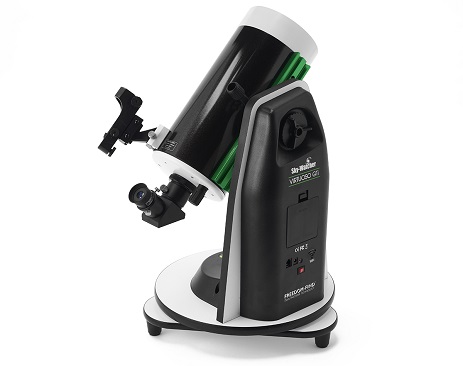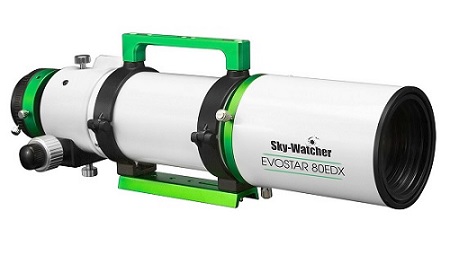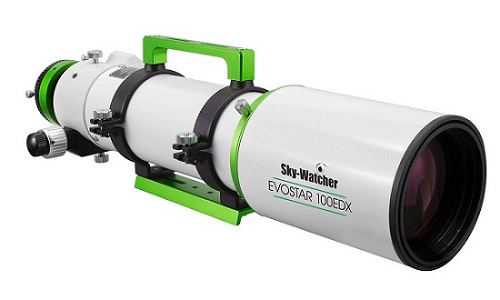|
|
YOUR FIRST SCOPE Starting out in astronomy, at some stage you’re going to get a "first scope”. Luckily for astronomers, a first scope can be got at superb quality and surprisingly reasonable cost. That said, there is a lot of crap around at the EUR 600 price point, especially if you look at such as eBay, so below I've listed a couple of items that represent extraordinary value for the optical quality they give. So good, in fact, that most astronomers will keep and use these telescopes even after having climbed the ladder and got bigger and more expensive stuff.It must be said first that although the first question for an aspiring astronomer is “what first scope?”, a scope purely on its own is no use without what's called a “Mount”. A mount usually comprises a tripod and a head, and although what I recommend below are a couple of slightly different "non-tripod" arrangements, the point is the same. The Mount must be sturdy and well-enough engineered to support and accurately point the scope. A scope at high magnification on a wobbly tripod/mount is completely useless. I suggest here some options for such a scope/mount package: 1. a "fast" f/5.0 150mm Newtonian; 2. a "slow" f/11.8 127mm Maksutov; 3. a refractor option further split between an 80mm scope on lightweight mount or a 100mm scope on a sturdier mount (with a "money-no-object" scope choice for each as well). The first two are of excellent optical quality (around 1/6 PV, in the parlance) and I consider it amazing they can be produced at that quality at these prices. I’ve used both myself, and saw the Veil Nebula for my very first time with the Heritage 150p’s smaller sibling, the 130p. Each very good scopes indeed. The third option is for a beginner that's prepared to spend more and go straight for "separates": i.e. telescope, mount, tripod and accessories, but still suitable for someone starting out. - - - Skywatcher Heritage 150p / Virtuoso GTi Mount. GBP 399 from firstlightoptics.com, price as at October 2025.
This is a Newtonian Reflector with a focal length of 750mm and 6” aperture. As scopes go, 750mm is on the short side, allowing lovely wide-field (31x magnification with a 24mm eyepiece) views of such as The Pleiades or the Double Cluster, but still capable of reaching, say, 250x magnification (with a 3mm eyepiece) for planets, double stars or the Moon. In this package the scope is supplied with Skywatcher's newish Virtuoso GTi mount, which in concert with Skywatcher’s SynScan App (free) can be controlled and pointed using a phone or tablet. The mount will track whatever it’s pointed at as the object moves across the sky with the Earth’s rotation, meaning you don't have to keep nudging it to keep it in the field of view. - - - Skywatcher SkyMax 127 / Virtuoso GTi. GBP 489 from firstlightoptics.com (October 2025 price, actually down from 2023!)
This is a type of scope called Maksutov-Cassegrain, with 127mm aperture (5”). It has a longer focal length than the Newtonian above, 1500mm (i.e. double), giving a higher range of magnifications. However it is not a long or big scope, shorter in fact than that above owing to the folded internal light-path using curved mirrors. It is superb on planets, double stars and the Moon, but not ideal for the really wide-field views of some of the larger Open Clusters. Minimum realistic mag will be around 50x, maximum perhaps 500x (way beyond what "atmospheric seeing" will permit or what most astronomers will ever use). The mount is the same as for the Heritage above. BUT ... while the main mirrors of both these scopes are excellent, they will be supplied with a pair of eyepieces, probably a 25mm and a 10mm. Why, I don't know. Even Skywatcher's multi-thousand Euro scopes come with these same eyepieces. The 25mm is not too bad but the 10mm is really poor, essentially useless. The first thing you should do is upgrade the eyepieces. I recommend “BST Starguider”, which retail for 50-60 and can readily be got used for 35 or so. For their price, they are superb. Thus, for a sum in the region of EUR 6-700, you can equip yourself with a scope which, as and if you progress to bigger and more expensive, you will still keep and use. I have a Heritage 150p/Virtuoso on my own current wish-list, it's just so portable. I started off with the exact Mak 127 above, and regret having sold it. - - - Separates - Refractors: 80mm on lightweight or 100mm on sturdier The two suggestions above are pointed at people who want a properly high quality scope/mount combination at minimal initial cost. Also, it’s often the kids who shout “I want a scope!”, but in fact the adults secretly do too. Those above cater for the dichotomy. However there are people who are interested in astronomy and not too worried about some initial cost. In an analogy with Hi-Fi, this section is for those prepared to go for “separates” rather than an all-in-one system. By “separates”, I mean separate mount head, tripod, telescope, accessories (diagonal, finder-scope, eyepieces); each component is then upgradeable independently. “Separates” will comprise a “mount” (a mount head sitting atop a tripod). The head is “pointable” in two axes, and must be sturdy enough and well-enough engineered to support, point and adjust the telescope without flexing or wobbling. In other words, a heavy or long telescope needs a heavy mount! Typically, a mount will cost as much or more than the telescope attached to it. Sad, but true (a bit like wood-burning stoves: the flue often costs more than the stove). A very expensive telescope is useless when “undermounted”; and it’s impossible to “overmount” a scope (sadly it’s not impossible to overmount your back). A common mistake in this category is to declare “money no object” and go right to the top. Spend five figures and get a mount plus scope that’s borderline professional. The problem here is that these are usually very big, very heavy and require years of experience to use properly. You cannot learn the early lessons with a mount weighing 30kg, and a scope, say a “C14” 14-inch SCT, weighing 21kg and awkwardly-shaped, which has to be lifted up onto the mount every time. And the whole ensemble needs to be assembled and dis-assembled every session, 30 minutes up and 30 minutes down once you’ve got used to it. When you order the kit, and open the lovely packaging, those practicalities don’t get thought of. Out of the box, assembled once only, no targets found or even brought to focus, never used again, is more common than you’d think. So my suggestion for the “separates” first-timer is for a mount and scope that are high quality yet still manageable for a beginner. I would suggest a 3.5-4” APO* or ED** refractor and a suitable Alt-Az mount. You’ll need a suitable 1.25” diagonal and eyepieces, and a low- or zero-magnification finder, to help get the higher magnification telescope pointing initially to the right place. Prices are as at October 2025 and in GBP including UK VAT. For non-UK, replace UK VAT with your own and there’ll likely be a small customs % as well. Clicking a link will open it in a separate page. An 80mm refractor on a lightweight set-up
Telescope: Skywatcher Evostar 80 EDX GBP 449 Mount: Skywatcher AZ-5 alt-az mount incl tripod and pillar GBP 257 Money-no-object 76mm Scope (Takahashi FC-76DS) plus necessaries GBP 2,078 A 100mm refractor on a sturdy mount
Telescope: Skywatcher Evostar 100 EDX GBP 599 Mount: Skywatcher Skytee2 alt-az heavy-duty mount incl tripod GBP 369 Money-no-object 100mm Scope (Takahashi 100DZ plus necessaries) GBP 3,491 To each of those you’ll need to add a diagonal (GBP 69), a finder (GBP 39) and eyepieces (I recommend BST Starguiders at GBP 55 each): Diagonal: 1.25" Stellalyra dielectric Finder (Red Dot type): Baader SkySurfer III Another little digression. An extremely common lifecycle for the lifelong astronomer is: Cheap 3”-or-4” refractor => bigger & bigger aperture, for example a 12" then a 20” Newtonian (i.e.highly infectious disease called “aperture fever”) => premium 4” APO refractor. The point being that almost all astronomers end up with a premium 4” refractor as their near-main scope. * APO stands for Apochromatic, a design of objective lens (typically a triplet, a three-lens group) enabling all colours to be brought
to the same focus point, eliminating colour-fringing and producing high contrast and high sharpness. back up
** ED stands for ”Extra-low Dispersion”, often in a doublet lens-group whereby one of the pair of elements of the objective lens-group is of a special low-dispersion material, also all but eliminating so-called chromatic aberration (colour fringing). back up AWAY-from-HOME OBSERVING CHECKLIST See below a check-list of those things you might want to remember when heading out to an observing trip away from home or for a club meet-up. If you’re like me, without a check-list, you’ll inevitably forget something crucial and - best case – you’ll have to borrow, say, a power cable from someone else; or – worst case – you won’t be able to observe at all, because you left your mount controller behind. We’ve all been there. For now, this list is aimed primarily at observers. Astro-photographers will likely have a slightly different list. When we get an "AP-er" on board, I'll get them to add one.Tripod + tray; Mount head; Actual telescope (OTA); Mount power supply (e.g. battery); battery cable; Mount controller handset; Phone/tablet; Controller cable; Finder; Eyepiece case; Accessories case (e.g. diagonals, adapters); Filters; Mount counterweights; Collimation tools; Dew/light shield; Head torch; Observing chair; Spirit level; |
|
email: [email protected] | tel/WhatsApp: 089 613 0361
|
|
What to get as a first telescope List of "things to remember" when observing away from home |



